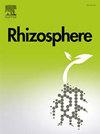Disruption of the endogenous indole glucosinolate pathway impacts the Arabidopsis thaliana root exudation profile and rhizobacterial community
IF 3.5
3区 生物学
Q1 PLANT SCIENCES
引用次数: 0
Abstract
Root exudates are composed of primary and secondary metabolites known to modulate the rhizosphere microbiota. Glucosinolates are defense compounds present in the Brassicaceae family capable of deterring pathogens, herbivores and biotic stressors in the phyllosphere. In addition, traces of glucosinolates and their hydrolyzed byproducts have been found in the soil, suggesting that these secondary metabolites could play a role in the modulation and establishment of the rhizosphere microbial community associated with this family. We used Arabidopsis thaliana mutant lines, including the cyp79B2cyp79B3 double mutant line with a disruption in the indole glucosinolate pathway and atr1D, which overexpresses ATR1 and increases glucosinolate production. These lines were analyzed using liquid chromatography-tandem mass spectrometry (LC-MS/MS) and 16S rRNA amplicon sequencing to evaluate how genetic modifications to the indole glucosinolate pathway affects the root exudate profile of Arabidopsis thaliana, and, in turn, impacts the rhizosphere microbial community. Metabolic analysis of root exudates from the wild-type Columbia (Col-0), along with the mutant lines, confirmed that alterations to the indole glucosinolate biosynthetic pathway result in shifts in the root exudate profile of the plant. We observed changes in the relative abundance of exuded metabolites. Moreover, 16S rRNA amplicon sequencing results provided evidence that the rhizobacterial communities associated with the plant lines used were directly impacted in diversity and community composition. This work provides further information on the involvement of secondary metabolites and their role in modulating the rhizobacterial community. Root metabolites dictate the presence of different bacterial species, including plant growth-promoting rhizobacteria (PGPR). Our results suggest that genetic alterations in the indole glucosinolate pathway cause disruptions beyond the endogenous levels of the plant, significantly changing the abundance and presence of different metabolites in the root exudates of the plants as well as the microbial rhizosphere community.
内源性吲哚硫代葡萄糖苷途径的破坏影响拟南芥根系分泌物特征和根际细菌群落
根分泌物由初级和次级代谢物组成,它们调节根际微生物群。硫代葡萄糖苷是存在于十字花科植物家族的防御化合物,能够阻止根层内的病原体、食草动物和生物应激源。此外,在土壤中还发现了硫代葡萄糖苷及其水解副产物的痕迹,表明这些次生代谢物可能在调节和建立与该家族相关的根际微生物群落中发挥作用。我们使用拟南芥突变系,包括吲哚硫代葡萄糖苷途径中断的cyp79B2cyp79B3双突变系和过表达ATR1并增加硫代葡萄糖苷产量的atr1D。利用液相色谱-串联质谱(LC-MS/MS)和16S rRNA扩增子测序对这些品系进行分析,以评估吲哚硫代葡萄糖苷途径的遗传修饰如何影响拟南芥根分泌物谱,进而影响根际微生物群落。对野生型哥伦比亚(Col-0)和突变系根系分泌物的代谢分析证实,吲哚硫代葡萄糖苷生物合成途径的改变导致植株根系分泌物谱的变化。我们观察到渗出代谢物相对丰度的变化。此外,16S rRNA扩增子测序结果表明,与所用植物系相关的根细菌群落的多样性和群落组成受到直接影响。这项工作提供了有关次级代谢物的参与及其在调节根细菌群落中的作用的进一步信息。根代谢产物决定了不同细菌种类的存在,包括促进植物生长的根细菌(PGPR)。我们的研究结果表明,吲哚硫代葡萄糖苷途径的遗传改变会导致植物内源水平以外的破坏,显著改变植物根分泌物中不同代谢物的丰度和存在以及根际微生物群落。
本文章由计算机程序翻译,如有差异,请以英文原文为准。
求助全文
约1分钟内获得全文
求助全文
来源期刊

Rhizosphere
Agricultural and Biological Sciences-Agronomy and Crop Science
CiteScore
5.70
自引率
8.10%
发文量
155
审稿时长
29 days
期刊介绍:
Rhizosphere aims to advance the frontier of our understanding of plant-soil interactions. Rhizosphere is a multidisciplinary journal that publishes research on the interactions between plant roots, soil organisms, nutrients, and water. Except carbon fixation by photosynthesis, plants obtain all other elements primarily from soil through roots.
We are beginning to understand how communications at the rhizosphere, with soil organisms and other plant species, affect root exudates and nutrient uptake. This rapidly evolving subject utilizes molecular biology and genomic tools, food web or community structure manipulations, high performance liquid chromatography, isotopic analysis, diverse spectroscopic analytics, tomography and other microscopy, complex statistical and modeling tools.
 求助内容:
求助内容: 应助结果提醒方式:
应助结果提醒方式:


